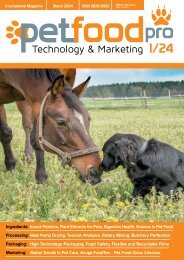Wellness Foods + Supplements 1/2022
Wellness Foods & Supplements is the first European magazine devoted exclusively to health ingredients, nutraceutical foods and beverages. Questions about the trade magazine Wellness Foods & Supplements? Interested in subscribing or advertising? The board of editors at Wellness Foods & Supplements kindly remains at your disposal.
Wellness Foods & Supplements is the first European magazine devoted exclusively to health ingredients, nutraceutical foods and beverages.
Questions about the trade magazine Wellness Foods & Supplements? Interested in subscribing or advertising? The board of editors at Wellness Foods & Supplements kindly remains at your disposal.
Create successful ePaper yourself
Turn your PDF publications into a flip-book with our unique Google optimized e-Paper software.
Microbiome<br />
It is now a generally accepted consensus that changes in the composition<br />
of our microbiome are associated with numerous diseases. This<br />
means that altering and enriching the microbiome can be used to<br />
maintain health and treat diseases. In particular, the gut microbiota<br />
critically intervenes in metabolism, immune system maturation, and<br />
the function of the central nervous system. This makes the microbiome<br />
a critical organ that influences the entire body.<br />
Gut Health 2.0 goes beyond digestion. Instead, it takes a holistic<br />
approach to health. Current research topics such as gut-immunity<br />
axis, gut-brain axis, gut-skin axis or gut-heart axis show the almost allencompassing<br />
significance of the human gut microbiome for human<br />
health. Axes represent the connections between the gut and individual<br />
human organs.<br />
An increasing number of studies demonstrate the incredible potential<br />
of the microbiome for various bodily functions. For example, it is<br />
now well established that a healthy microbiome is directly related to<br />
the skin’s health. As a multifunctional organ, it requires many micronutrients<br />
that are absorbed through the gut. Similarly, a dysfunctional<br />
microbiome is often closely related to metabolic diseases such as<br />
type 2 diabetes mellitus 2 .<br />
The microbiome also regulates the fitness of the immune system 3 .<br />
Healthy ageing and a longer life are also linked to the microbiome.<br />
A recent study 4 carried out in the United States shows that a high<br />
level of uniqueness and diversity of the microbiome is associated with<br />
increased survival. The microbiome-gut-brain axis takes on particular<br />
importance in studies. It is becoming clear that the composition and<br />
metabolism of the microbiome not only exert an important influence<br />
on mental disorders but also affect weight regulation.<br />
GUT-BRAIN AXIS<br />
GUT MICRO-<br />
BIOTA<br />
G U T - S K<br />
HPA<br />
GUT-<br />
BRAIN-<br />
SKIN<br />
AXIS<br />
I N<br />
BRAIN-SKIN AXIS<br />
A X I S<br />
PSORIASIS<br />
Even fitness and musculature are closely linked to the microbiome.<br />
For example, Swedish researchers 5 from the Karolinska Institute in<br />
Stockholm discovered in mice experiments that gut bacteria strongly<br />
influence normal skeletal muscle function. In any case, a holistic<br />
view of the body is essential for maintaining and improving health.<br />
The latest scientific findings show that a<br />
well-functioning, diverse microbiome has a<br />
central role as a control instrument for many<br />
aspects of the human body.<br />
Prebiotics, probiotics, synbiotics,<br />
and postbiotics:<br />
the supporters of the microbiome<br />
When something is as essential as the microbiome,<br />
we should do everything we can to<br />
keep it in good shape. Fortunately, the<br />
digestive system comprises several built-in<br />
supporters for this:<br />
Probiotics – the viable microorganisms that<br />
multiply in the gut and, in sufficient quantities,<br />
impart health benefits to the host.<br />
Prebiotics – the non-digestible food components<br />
that boost growth and activity of ba<br />
cteria in the colon. They also block the<br />
binding of harmful bacteria.<br />
Synbiotics – a combination of probiotics and<br />
prebiotics that synergistically combines the<br />
benefits of both.<br />
Postbiotics – byproducts of the fermentation<br />
process. These are soluble factors secreted<br />
by live bacteria or released after bacterial<br />
lysis and provide physiological benefits to the<br />
host. However, for many scientists, the definition<br />
of postbiotics was not clear enough. In<br />
2021, seeking clarity on what qualifies as a<br />
postbiotic, a panel of experts at the International<br />
Scientific Association of Probiotics and<br />
Prebiotics (ISAPP) sought a new definition 6 .<br />
They defined a postbiotic as a “preparation<br />
of inanimate microorganisms and/or their<br />
components that confers a health benefit on<br />
the host”.<br />
Prebiotics – much more than<br />
a trendy product<br />
The demand for advanced prebiotics that<br />
have no side effects and are intended<br />
to support specific areas in the body is<br />
increasing permanently. Certain prebiotics<br />
are particularly beneficial for the microbiome.<br />
They target particular bacteria, which<br />
produce a high amount of short-chain fatty<br />
acids. SCFAs do not have to be modified<br />
during digestion and absorbed directly by the<br />
body. According to current research, shortchain<br />
fatty acids serve as “food”, especially<br />
16 No. 1 April/May <strong>2022</strong>


















